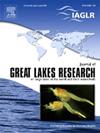New method for identification of natural and anthropogenic organic matter in receiving waters of pulp and paper mill discharge
IF 2.5
3区 环境科学与生态学
Q3 ENVIRONMENTAL SCIENCES
引用次数: 0
Abstract
Pulp and paper mills (PPMs) are one of the most water-intensive industries in the world. Where sulphite pulping is used to produce pulp for paper and other products, lignosulfonates (LSF) dominate the organic component of PPM wastewaters. Currently, there is no information about the quantitative composition of organic matter (OM) and contribution of LSF to the OM pool in lakes and rivers located within the zone of PPMs’ influence. Addressing this gap in our understanding, a method was developed for the characterization of allochthonous (humic substances, HS) and anthropogenic (LSF) components of OM, and labile organic substances. The method is based on the extraction of HS from a water sample with DEAE-cellulose, introducing an experimentally determined adjustment coefficient for partial LSF sorption. The method was applied to the second largest freshwater lake in Europe, Lake Onego (also known as Onega), and its Kondopoga Bay, receiving wastewaters of Kondopoga PPM. The method’s effectiveness was demonstrated through spatial segregation of the river and wastewaters in the bay in different seasons, first as a source of HS, and the second as a source of LSF. The vertical distribution of the river and wastewaters was indicated using conductivity, temperature, and TP. The proposed method demonstrated that HS in Kondopoga Bay make up on average 63% of the total OM pool and 17% of labile OM. However, LSF accounts for an average of 20% and up to 39% of the total OM pool, which confirms the high degree of anthropogenic impact on water quality of the bay.
纸浆和造纸厂排放污水中天然和人为有机物质鉴定的新方法
纸浆和造纸厂(PPMs)是世界上最耗水的工业之一。在亚硫酸盐制浆用于生产纸张和其他产品的纸浆时,木质素磺酸盐(LSF)在PPM废水的有机成分中占主导地位。目前,PPMs影响区内湖泊和河流中有机质(OM)的定量组成和LSF对OM库的贡献尚无相关资料。为了解决这一认识上的差距,我们开发了一种方法来表征OM的异域(腐殖质,HS)和人为(LSF)成分,以及不稳定的有机物。该方法基于deae -纤维素从水样中提取HS,引入了实验确定的部分LSF吸附调节系数。该方法应用于欧洲第二大淡水湖奥涅戈湖(也称为奥涅加湖)及其孔多波加湾,接收孔多波加PPM的废水。该方法的有效性通过对不同季节的河流和海湾废水进行空间隔离来证明,首先是HS的来源,其次是LSF的来源。利用电导率、温度和总磷来表示河流和废水的垂直分布。所提出的方法表明,Kondopoga湾的HS平均占总OM库的63%,占不稳定OM的17%。然而,淡水区平均占总海水池的20%,最高可达39%,这证实了人为对海湾水质的高度影响。
本文章由计算机程序翻译,如有差异,请以英文原文为准。
求助全文
约1分钟内获得全文
求助全文
来源期刊

Journal of Great Lakes Research
生物-海洋与淡水生物学
CiteScore
5.10
自引率
13.60%
发文量
178
审稿时长
6 months
期刊介绍:
Published six times per year, the Journal of Great Lakes Research is multidisciplinary in its coverage, publishing manuscripts on a wide range of theoretical and applied topics in the natural science fields of biology, chemistry, physics, geology, as well as social sciences of the large lakes of the world and their watersheds. Large lakes generally are considered as those lakes which have a mean surface area of >500 km2 (see Herdendorf, C.E. 1982. Large lakes of the world. J. Great Lakes Res. 8:379-412, for examples), although smaller lakes may be considered, especially if they are very deep. We also welcome contributions on saline lakes and research on estuarine waters where the results have application to large lakes.
 求助内容:
求助内容: 应助结果提醒方式:
应助结果提醒方式:


